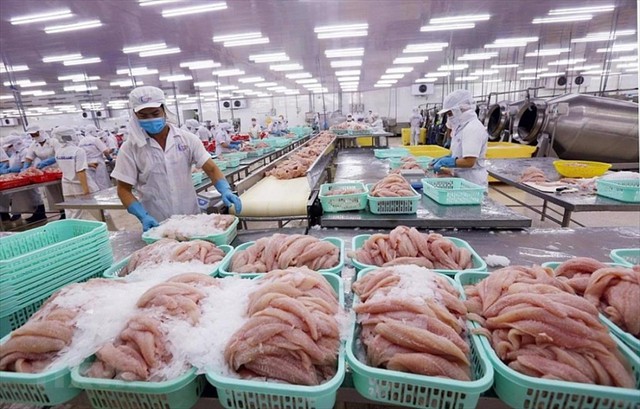VASEP said loan interest rates are the biggest challenge for the industry so the association hoped the Government, the Ministry of Finance and the central bank will solve this challenge.

Deputy Prime Minister Lê Minh Khái has requested the State Bank of Việt Nam and relevant ministries and organisations to consider solutions to solve financial difficulties of enterprises in the fishery sector.
Specifically, according to Document No. 639/TTg-KTTH signed by Deputy Prime Minister Lê Minh Khái on July 12, SBV has been requested to coordinate with the Ministry of Agriculture and Rural Development (MARD), and relevant ministries and organisations to consider adjusting lending rates, granting credit, restructuring debts, as well as preparing a credit package of VNĐ10 trillion to support enterprises in the forestry and aquatic industries.
The document was issued in reply to the Việt Nam Association of Seafood Exporters and Producers (Vasep)'s official dispatch which reports their challenges and propose solutions to remove the difficulties of the fishery industry.
Accordingly, seafood enterprises have been facing many difficulties, such as high production and transportation costs, depleted capital, high borrowing interest rates, and reduced orders, so they have struggled to maintain production and business activities, and needed solutions to solve problems in a timely manner.
VASEP said loan interest rates are the biggest challenge for the industry so the association hoped the Government, the Ministry of Finance and the central bank will solve this challenge.
VASEP recommended that banks cut the interest rate to below 4 per cent for US dollar loans and below 7 per cent for Vietnamese đồng loans to support export enterprises.
It also suggested that seafood enterprises be allowed to delay payment of 4-6 months for the loans having maturity date in the third quarter of 2023. They also continue to take loans to stably purchase raw materials for processing goods exported until this year's end.
In addition, VASEP believed that it is necessary to have a credit package of VNĐ10 trillion to support the seafood businesses in purchasing fishery materials from farmers.
Also in Document No. 639/TTg-KTTH, Khái requested the Ministry of Finance to coordinate with relevant ministries and agencies to urgently implement value-added tax refund for businesses according to current regulations.
At the same time, they must consider and respond to VASEP's recommendations on prolonging policies on exemption and reduction of tax, land rent, fees and charges as well as extension of payment for those.
The central bank and the Việt Nam Bank for Social Policies are asked to consider and respond to recommendations on continuing lending to the seafood enterprises from the social policy bank to pay wages for workers having to quit jobs.
The Ministry of Planning and Investment coordinates with MARD and relevant ministries, agencies and localities to simplify investment procedures in setting up new seafood processing factories and innovating technology to increase capacity.
According to VASEP, in the first six months of 2023, total seafood export turnover reached US$4.13 billion, down 27.4 per cent over the same period in 2022, reaching 41.5 per cent of the plan.
Of which, the total export turnover in June was estimated at nearly $800 million, down 21 per cent over the same period in 2022. Key seafood products saw a strong reduction in June as well as in the first half of this year.
Shrimp exports in June were estimated at $341 million, the highest level since the beginning of the year. But it was still down 18 per cent year on year. In the first half of the year, shrimp exports reached nearly $1.6 billion, 31 per cent lower than in the first half of 2022.
Pangasius export in June was estimated at $156 million, an reduction of 26 per cent on year. This figure in the first six months was estimated at $885 million, 38 per cent lower than the same period of last year.
Tuna export turnover reached $64 million in June, down 29 per cent on year. This turnover was $380 million in the first half of the year, down 31 per cent compared to the corresponding period in 2022. — VNS





